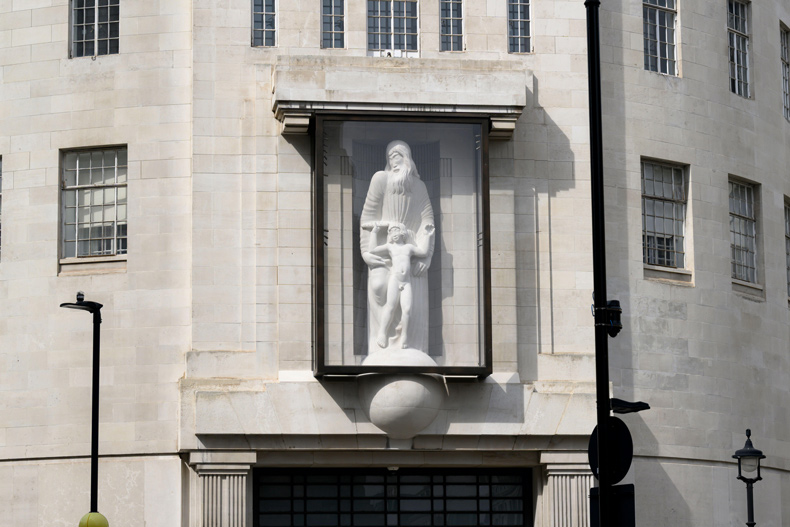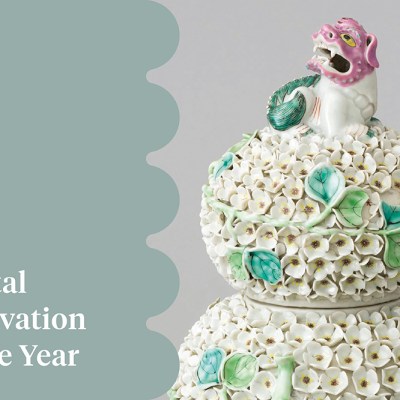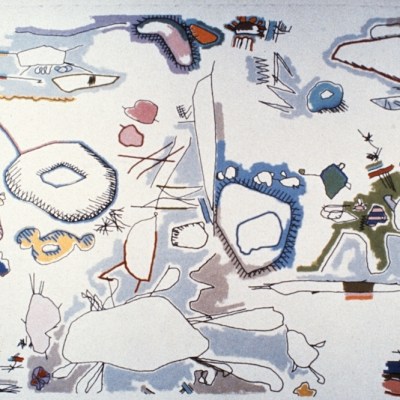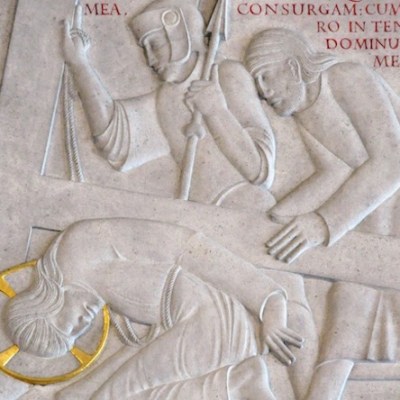From the June 2025 issue of Apollo. Preview and subscribe here.
How do you solve a problem like Eric Gill? For the BBC, a QR code is part of the answer. Eric Gill’s statue, Prospero & Ariel, mounted on the prow of Broadcasting House in central London, was attacked with hammer and chisel in 2022 and 2023. A man arrested after the second attack is awaiting trial. Prospero & Ariel, made in 1932, has become an embarrassing figurehead for the BBC because of Gill’s abuse of his daughters, incestuous affairs, and sexual experiments with a dog, all of which were revealed in the late 1980s, long after the artist’s death. There have been calls for the removal of his work from Broadcasting House and elsewhere ever since.
So, what can the BBC do? There’s a broad consensus that Prospero & Ariel should not be removed; it is a significant work in its own right and an integral part of a landmark building. The restored statue, which was unveiled in April this year, has been enclosed in a glass case, not unlike those Perspex boxes some inner-city supermarkets put around joints of meat to prevent shoplifting. This permanent architectural intervention is accompanied by an ugly fortification of temporary planters and galvanised fences on the pavement, which rather undercuts claims about preserving the appearance of the building. But that’s not all. There’s also ‘a QR code which links to information about the history of the building, Eric Gill and the sculpture’s restoration’, according to BBC News’s own report on the subject.
What exactly this QR code is meant to achieve is a little unclear, and the questions only multiply when you find it, mounted in a window on the ground floor of the building. (There are in fact two, but they link to the same place.) ‘Explore the history of Broadcasting House here,’ says the sign, rather than anything specifically about Gill, and that’s what the link provides, with the following detail embedded in the sixth paragraph:
Revelations about Gill’s private life in a 1980s biography created a backlash against him; and while the BBC in no way condones his abusive behaviour, it draws a line between his life and his artistic creations.
This is reticent and lawyerly – a fair summary of a reasonable stance. But what on earth is the QR code for? Who is it for? A casual passer-by may be interested to learn more about Colonel Val Myer’s art deco hulk. But the code is clearly intended as a load-bearing part of the BBC’s mitigation of discomfort around the retention of Prospero & Ariel – the corporation says as much in its news story, which highlights the code as if it is significant in itself. Why? It cannot be intended to deter further attacks to the statue. It’s simply impossible to imagine a sequence of events in which a vandal is turned around by this sign. The sign instead seems to be a way to forestall any further criticism.
The gesture smacks of bureaucratic obfuscation, sliding between concealment and openness. It promises more information, but only if you are motivated enough to stop, take out your phone, and use the code to connect to the linked website. In the event of any further complaints, the BBC can point to the QR code as its acknowledgement of the issue, while keeping any real acknowledgement safely out of sight. It is a kind of fig leaf for the BBC’s institutional embarrassment over Gill – one that highlights the rise of the QR code, and its curiously ambiguous meanings.
Eric Gill’s Prospero & Ariel (1932), now behind glass at Broadcasting House in London. Photo: Alex MacNaughton/Alamy Stock Photo

In the past decade, the QR code has become widespread enough to dissolve into invisibility. This has been especially true in galleries and museums, where QR codes are increasingly used to connect visitors with resources such as audio guides, or for enhanced experiences. Smartify, a company that develops these experiences, has more than 700 partners, including the National Gallery and many other major institutions. But the code had much more utilitarian origins. Developed in 1994 by an engineer called Masahiro Hara at an automotive parts company in Kariya, Japan, the QR code was initially used for stock control and logistics. ‘QR’ stands for ‘quick response’. Numeric barcodes were becoming cumbersome and Hara was tasked with finding a way of more densely encoding information for more rapid retrieval; the chequerboard QR code was his solution, inspired by the arrangement of pieces on a Go board.
The codes can be a variety of sizes, depending on the amount of information that must be encoded. The largest QR code can carry more than 4,000 alphanumeric characters, a little less than half the length of this article. But their real genius is the maths underlying their encryption, a technique called Reed-Solomon error correction, which means that information can be successfully retrieved from an incomplete or partially obscured code, making them a lot more flexible and resilient than suggested by their visual complexity.
The QR code broke free of the warehouse and the assembly line in the 2000s, thanks to the rise of internet-connected smartphones with cameras. Back then they were riding on a wave of early excitement about ‘augmented reality’, when it seemed that a rich digital layer might soon accompany our every step. While a few of those promises have come to pass, nowadays the QR code is mostly used as a handy way to communicate a web address to a user’s phone without laboriously copying it out. But, just as was feared almost 20 years ago, this means that an increasing amount of the informational surface area of our world is readable only by machine. Which leaves the question of what the QR code means to us without the involvement of machines – what we think, or don’t think, when we see one of those inscrutable little tablecloths.
To understand what’s meant by this, let’s consider the QR code’s ancestor, the barcode. Barcodes, which were first implemented in 1974, use a series of thick and thin lines to represent numbers and are read by a reflecting laser. It’s not a complicated technology – indeed, unlike QR codes, the most commonly occurring barcodes can be read by the human eye, as easily as understanding Morse code. This is, however, a fairly useless party trick. Although barcodes are used in scores of applications, the place they are most familiar is in retail, where they bring up the prices of products.
Thus, everything for sale in a shop with electronic stock-keeping is marked with a barcode. The barcode has in turn picked up symbolic meaning: this item is for sale. In satire and illustration, a barcode means something commodified, packaged and on the market. Applying a barcode to a human being is therefore an affront to human dignity, a sign that human life has been cheapened and individuality lost, such as in Mike Judge’s film Idiocracy (2006). QR codes, which are mostly used to convey web addresses, do not have that connotation. But whereas the barcode has information only for machines, the QR code promises something for us humans: whatever lies at that web address.
As a human symbol, then, the QR code functions as a kind of ellipsis, a veil, with the promise of more beyond. They are both enticement and obstacle. This is mirrored in the debates over accessibility that surround them in gallery and museum settings: whether they make information easier to access or more difficult for anyone who doesn’t have the relevant technology, or who would prefer not to use it.
The pandemic led to a surge in the use of QR codes, as businesses sought contactless transactions; it became, for instance, everyone’s least favourite part of going to a restaurant. Popular or not, this brute-forcing of QR interactions means people are more accustomed to the codes, which in turn have driven their spread. Posh estate agents hide the prices of their properties behind them; in my east London neighbourhood, trees have them, asking passers-by to become ‘watering champions’. But might this be the final supernova flare of the technology before it disappears? When I was writing about augmented reality for a design magazine in 2009, QR codes were already being described by experts as an ‘absolutely stone-age’ way of interacting with digital content. In the near future, it was assumed, information could be accessed through image-recognition and location software. Now that phone cameras can recognise text, copy it, and know when they’re looking at a URL, do we still need QR codes? The QR code was a way of making the world more machine-readable; now that the machines are pretty good at reading the world as we see it, might it be on the way out?
The decorative screen designed in 1934 by Edward Bainbridge Copnall at the Royal Institute of British Architects in London. Photo: Christopher Hope-Fitch/RIBA Collections

Unless, of course, your intention is to hide rather than to reveal. A few blocks away from the BBC, at the headquarters of the Royal Institute of British Architects (RIBA), there is another example of contextual labelling to mitigate institutional embarrassment, but handled rather differently. Edward Bainbridge Copnall’s decorative screen in the Henry Jarvis Memorial Hall was completed in 1934, just two years after Prospero & Ariel. Today, its depictions of Indigenous peoples as primitive make it an uncomfortable sight, and RIBA has come under pressure to remove it. While its future is still being decided, an explanatory label beside the mural acknowledges its offensive aspects while neither condoning nor condemning. Of course, there’s a QR code, but only as an addendum. All the salient information is on the label. While that will not satisfy everyone, it at least recognises the existence of the issue, which the BBC appears at pains to avoid.
There’s one last problem with the QR codes at Broadcasting House. Raising my phone to take a picture of the label, and interact with the code, I was challenged by a security guard. Was I taking a photograph through the window, of the people working in the building? No, I said, I’m trying to use this QR code. There have been complaints, the guard said apologetically. If you don’t want people pointing their phones at the windows, I said, then really the sign should be mounted on the wall. He shrugged in agreement. I wondered how often he had had the exact same interaction. In navigating one potential hazard to its employees, the BBC appears to have created another; it may seem obvious but institutions should remember that putting up a QR code tells people: ‘Point your phone here’.
From the June 2025 issue of Apollo. Preview and subscribe here.


